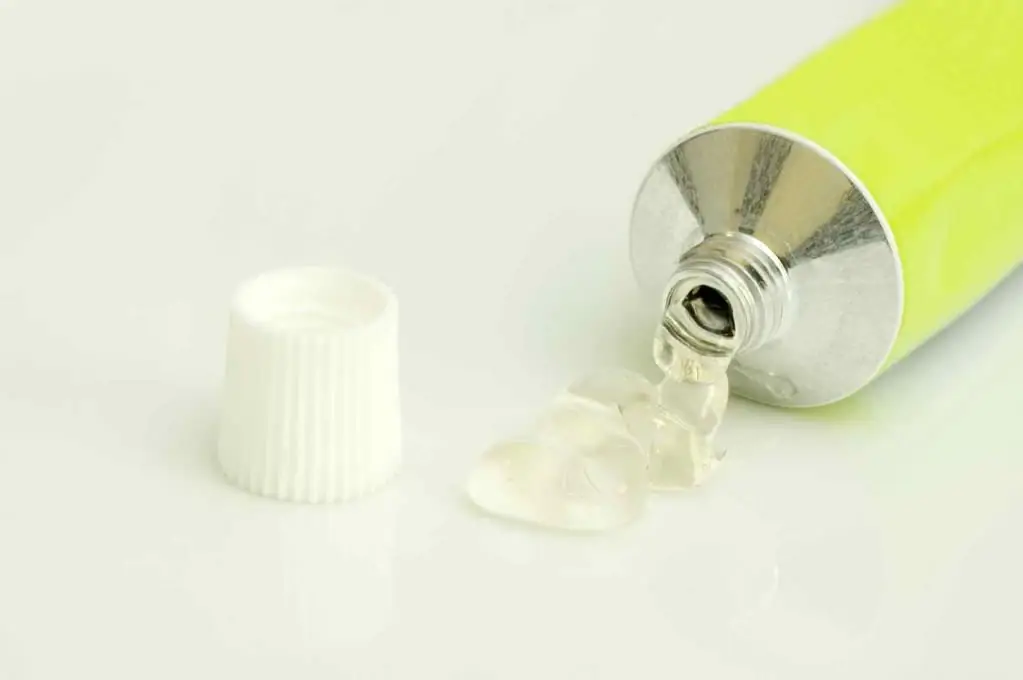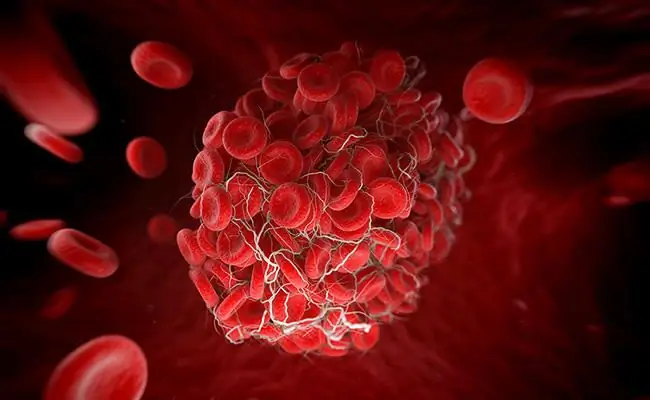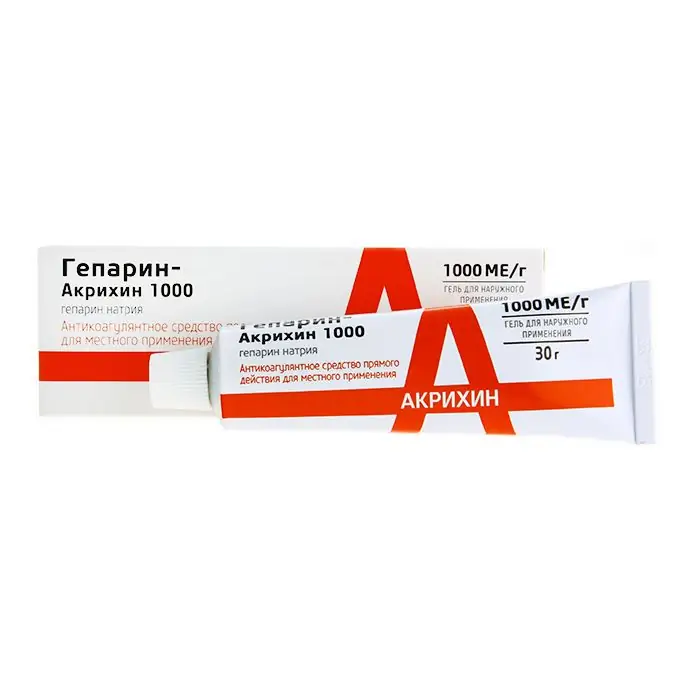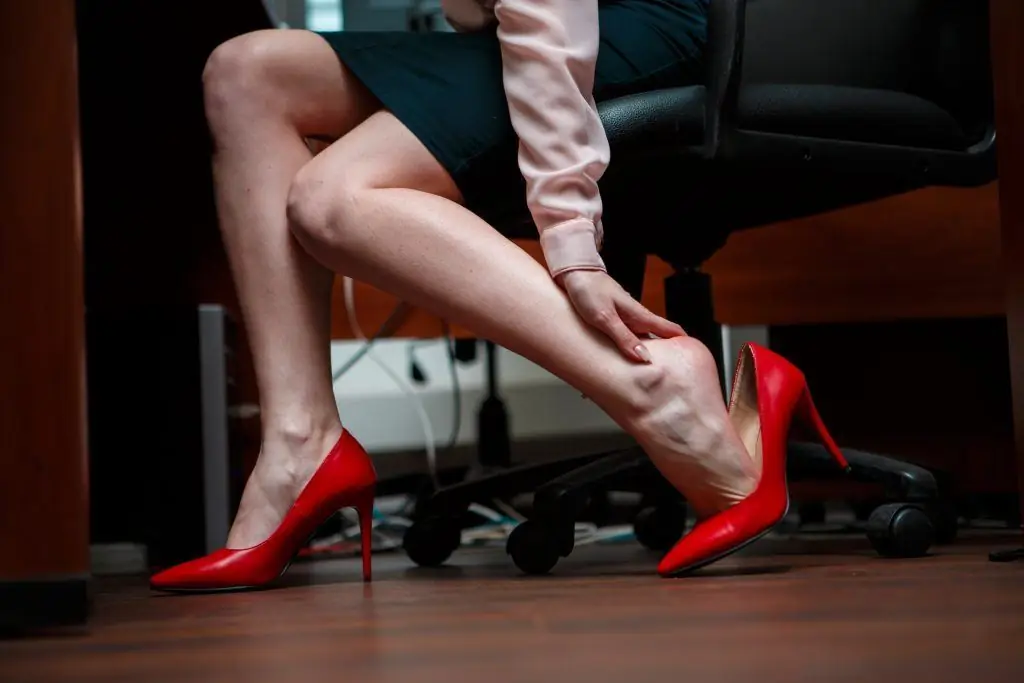- Author Curtis Blomfield [email protected].
- Public 2023-12-16 20:44.
- Last modified 2025-01-23 17:01.
Thrombosis is called the intravital formation of blood clots or blood clots inside blood vessels. They prevent the free movement of plasma through the human circulatory system, which can lead to disastrous consequences.
When blood vessels are damaged, the body uses fibrin and platelets to form a kind of “plug” that prevents blood loss. However, under certain conditions, blood clots are formed without any damage to the vessels. When the clot covers more than 75% of the entire area of the arterial lumen, the flow of oxygen to the tissues decreases so much that the patient shows signs of accumulation of metabolic products in the body and hypoxia.
Specialists identify the following factors that contribute to the development of thrombosis:
- damage to vessel walls;
- blood composition (thrombophilia or hypercoagulability);
- character of blood flow (turbulence, stasis).

What drugs are used for thrombosis? One of the most popular means is Heparin-Akrikhin 1000 gel. Instructions for the use of this medication, its composition, pharmacological features, side effects and other information are presented below.
Composition, drug packaging, description
"Heparin-Akrikhin" - a gel intended for external use. Such a product is a transparent or almost transparent, colorless or slightly yellowish mass, with a specific odor.
What components does Heparin-Akrikhin contain? The composition of this tool includes such an active ingredient as sodium heparin. As excipients, the preparation in question contains: methyl parahydroxybenzoate, lavender oil, carbomer, purified water, trometamol, 96% ethanol (rectified ethyl alcohol), orange flower oil (or neroli oil).
Heparin-Akrikhin gel goes on sale in aluminum tubes, which are placed in cardboard packs.

Pharmacological features
What is heparin sodium? The active component of the agent in question is a direct-acting anticoagulant. It belongs to medium molecular weight heparins. Once in the blood plasma, this substance is able to activate antithrombin III, thereby increasing its anticoagulant properties.
Gel with sodium heparin inhibits the activity of thrombin, disrupts the conversion of prothrombin to thrombin, and also reducesplatelet aggregation (to some extent).
Other properties
What other properties are inherent in the drug "Heparin-Akrikhin"? According to the instructions, such a drug is able to increase renal blood flow, increase the resistance of cerebral vessels, reduce the activity of hyaluronidase, activate lipoprotein lipase and exhibit lipid-lowering effects. In addition, the agent under consideration well reduces the activity of the surfactant in the patient's pulmonary system, suppresses the synthesis of aldosterone in the adrenal cortex, increases the activity of parathyroid hormone, binds adrenaline, and also modulates the ovarian response to hormone stimuli.
When interacting with enzymes, such a drug can increase the activity of pepsinogen, brain tyrosine hydroxylase, DNA polymerase and reduce the activity of pyruvate kinase, myosin ATPase, pepsin and RNA polymerase. There is also evidence of immunosuppressive activity in sodium heparin gel.

Impact features
How does the drug "Heparin-Akrikhin" affect the patient's body? In people with coronary artery disease (in combination with ASA), the use of such an agent reduces the risk of developing thrombosis (acute) of the coronary arteries, sudden death and myocardial infarction. Also, the use of this medication reduces the frequency of deaths and recurrent heart attacks. In high dosages, the gel in question is effective in venous thrombosis and pulmonary embolism, and in small doses it is actively used for prophylactic purposes of venous thromboembolism, includingafter surgery.
When applied externally, "Heparin-Akrikhin" has a local antiexudative, antithrombotic and anti-inflammatory (moderate) effect. Such a drug has a depressing effect on the activity of hyaluronidase, blocks the formation of thrombin, and also activates the fibrinolytic properties of plasma.
Heparin, penetrating the skin, reduces inflammation and has an antithrombotic effect. Also, this substance activates tissue metabolism and improves microcirculation, thereby accelerating the processes of resorption of blood clots and hematomas, and reducing tissue swelling.
Pharmacokinetic properties
A small amount of the active substance of the drug is absorbed from the surface of the skin into the systemic circulation. At the same time, its maximum concentration is noted 8 hours after application.
The excretion of heparin sodium occurs through the renal system. The half-life of the drug is 12 hours. Due to the large molecular weight, the active component of the gel does not penetrate the placenta well, and also does not enter breast milk.

Indications for prescription
What is Heparin-Akrikhin used for? Indications for the use of this remedy are the following conditions (for prevention and for therapy):
- deep vein thrombosis;
- thrombophlebitis;
- pulmonary embolism (especially in peripheral vein disease);
- DIC;
- thrombosis of the coronary arteries;
- myocardial infarctionsharp;
- unstable angina;
- atrial fibrillation (especially accompanied by embolism);
- microcirculation disorders, microthrombosis;
- bacterial endocarditis;
- renal vein thrombosis;
- hemolytic uremic syndrome;
- glomerulonephritis;
- mitral heart disease, thrombosis;
- lupus nephritis.
Also, the medication in question is prescribed for the prevention of blood clotting during surgical interventions using extracorporeal circulation methods, during hemosorption, hemodialysis, forced diuresis, peritoneal dialysis, citapheresis and during washing of venous catheters.

Sometimes such a preparation is necessary for the preparation of samples of non-clotting blood during transfusion and for laboratory purposes.
Prohibitions on prescribing gel for external use
In what cases can not Heparin-Akrikhin be used? The following conditions are contraindications to the use of such a remedy:
- bleeding, antiphospholipid syndrome, diseases that are accompanied by a violation of the blood coagulation process;
- erosive and ulcerative lesions of the digestive tract, intracranial hemorrhage or suspicion of it, cerebral aneurysm;
- dissecting aortic aneurysm, hemorrhagic stroke, liver cirrhosis accompanied by varicose veins, malignant arterial hypertension;
- bacterial endocarditissubacute, high sensitivity to heparin, severe liver parenchymal lesions, shock conditions;
- Malignant neoplasms in the esophagus and liver, threatened miscarriage, recent eye, prostate, brain, biliary tract, liver, menstruation, condition after spinal cord puncture, childbirth (recent).
It should also be noted that Heparin-Akrikhin gel is not used for ulcerative necrotic processes and is not applied to mucous membranes and open wounds.

Dosage of external agent
The dosage of the drug in question is individual and depends on the clinical situation, indications and age of the patient. The gel is applied externally, in a thin layer (at the rate of 3-5 cm of gel on a skin area up to 3-5 cm in diameter) and gently rubbed in.
Use the medication 1-3 times a day daily until the inflammation is completely eliminated. The terms of treatment are determined by specialists (on average from 3 days to one week).
Side Effects
What negative consequences can cause the use of the drug "Heparin-Akrikhin"? Side effects of this remedy include:
- nausea, bleeding of the urinary tract and gastrointestinal tract, flushing of the skin, bleeding in areas that are subjected to pressure (from surgical wounds), feeling of heat in the soles, hematuria, decreased appetite, thrombocytopenia;
- vomiting, drug fever, pruritus, diarrhea, bronchospasm, elevated liver transaminases, collapse, osteoporosis;
- urticaria, spontaneous fractures, rhinitis, soft tissue calcification, anaphylactic shock, thrombocytopenia, skin necrosis, application site irritation, arterial thrombosis;
- transient alopecia, gangrene, flushing, myocardial infarction, hematoma, stroke, hypoaldosteronism, pain and ulceration at the site of application.
"Heparin-Akrikhin": drug interactions
Thyroxine, ergot alkaloids, antihistamines, nicotine and tetracycline reduce the effects of sodium heparin.
The anticoagulant properties of "Heparin-Akrikhin" are enhanced with the simultaneous use of antiplatelet agents, anticoagulants and NSAIDs.
Overdose cases
What are the consequences of an overdose of Heparin-Akrikhin? According to the instructions, an overdose, especially with an external agent, is unlikely due to the low absorption of the gel components. However, in some cases, excessive application of the drug is accompanied by increased bleeding. In such situations, it is better to refuse the use of the drug (bleeding is removed by means of a chemical antagonist).

It's important for everyone to know
With extreme caution, the drug in question should be prescribed to people suffering from polyvalent allergies, as well as arterial hypertension, diabetes mellitus, dental procedures, active tuberculosis, endocarditis, radiation therapy, pericarditis, the presence of an intrauterine contraceptive, liver failure, chronic renal failure character,in elderly patients.
With caution, Heparin-Akrikhin gel is used externally for thrombocytopenia and increased bleeding.
During the period of treatment with heparin, monitoring of the parameters of the blood coagulation process is required.
The risk of bleeding can be minimized with careful assessment of contraindications to the use of the gel, adequate dosing and regular monitoring of the blood coagulation process.






